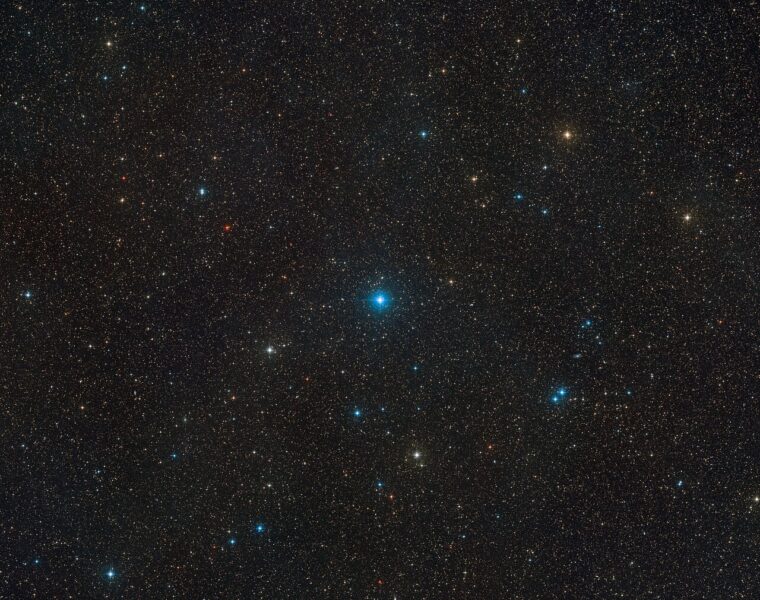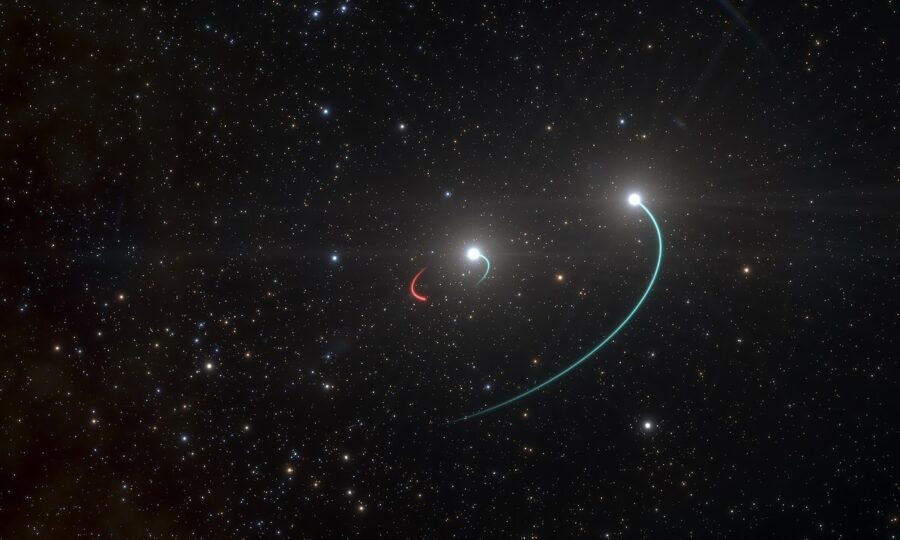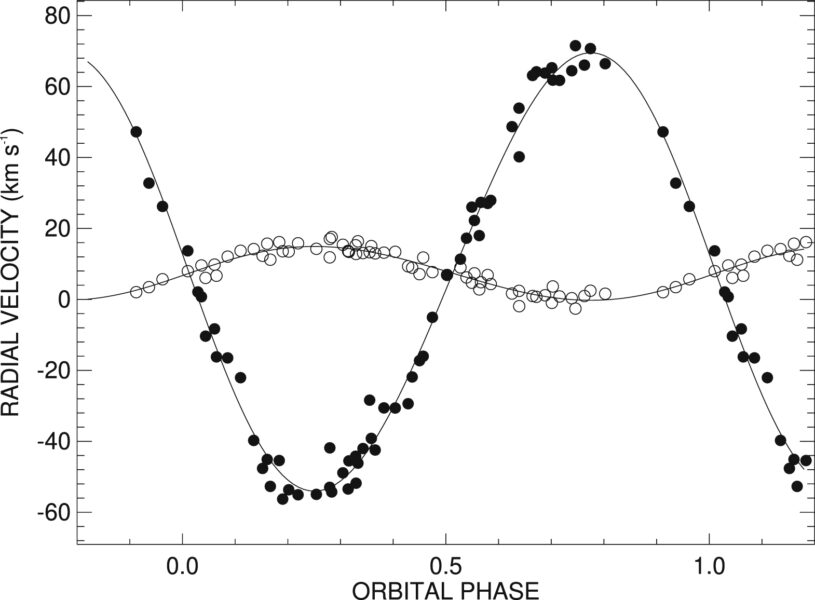New research has shown that the recently-discovered closest black hole to Earth might not be a black hole after all but a binary star.

ESO / Digitized Sky Survey 2; Acknowledgement: Davide De Martin
A few months ago, scientists announced the indirect detection of the nearest black hole to Earth. But another team is now suggesting a different explanation for this stellar puzzle.
HR 6819: History of a Mystery
From the earliest spectra of HR 6819, scientists identified this source as a bright, early-type Be star — a hot star with emission lines, likely due to the accretion of a circumstellar disk of material. As our ability to resolve detail in stellar spectra has advanced, however, a more complicated picture has emerged.
Studies in the 1980s revealed unexpected narrow absorption lines in HR 6819’s spectra, and a 2003 study showed that these lines were moving over time. This indicated that, though we couldn’t optically resolve them, there were two components of HR 6819: a Be star exhibiting no obvious motion, and a B3 III star on a 40-day orbit.

ESO / L. Calçada
But what was the B3 III star orbiting? In May 2020, scientists announced an answer to the puzzle: HR 6819 must actually be a triple system. The B3 III star, they argued, is orbiting a black hole (which is why we don’t see evidence of it in the spectra), and the Be star is a distant tertiary companion, orbiting too slowly to have detectable motion.
Based on the B3 III star’s orbit, the black hole would need to weigh more than 4 solar masses — and at just 1,120 light-years distance from Earth, this object would be the closest black hole known. But could there be another explanation for HR 6819’s spectra?
Just the Two of Us
In a new study, Georgia State University scientists Douglas Gies and Luqian Wang argue that HR 6819 isn’t a triple system after all. Instead, it’s a simple binary, consisting only of the two known components: the Be star, and the B3 III star.
If HR 6819 is merely a binary, then the Be star should show reflex orbital motion with the same period of 40 days — but this motion could be small, and hard to detect in the complex spectra of the system.
To look for it, Gies and Wang analyzed the Hα emission from the accretion disk surrounding the Be star. Using careful spectral modeling, they show that the entire disk can be seen to wiggle back and forth with a period of 40 days, exactly as expected for reflex orbital motion. This motion is roughly an order of magnitude less than that of the B3 III star, which is why it wasn’t previously spotted.

Gies & Wang 2020
An Unequal Pair
So why is the Be star’s orbital motion so much smaller than that of its B3 III companion? If the Be star has a typical mass of ~6 solar masses, the companion must be only a fraction of a solar mass in size. It may be in a stage of evolution where it’s already donated a significant amount of mass to its companion, and now only the stripped-down remnant remains.
Is the case closed on HR 6819? Far from it! This system continues to challenge our assumptions and gives us the opportunity to practice the process of science as we work to explain our observations.
Citation
“The Hα Emission Line Variations of HR 6819,” Douglas R. Gies and Luqian Wang 2020 ApJL 898 L44. doi:10.3847/2041-8213/aba51c
This post originally appeared on AAS Nova, which features research highlights from the journals of the American Astronomical Society.
 10
10









Comments
misha17
October 20, 2020 at 12:37 pm
Did you mean the (outer) Be star, and not the (inner) B3 III star, in the sentence below?
"If HR 6819 is merely a binary, then the B3 III star should show reflex orbital motion with the same period of 40 days — but this motion could be small, and hard to detect in the complex spectra of the system."
You must be logged in to post a comment.
Douglas Gies
October 22, 2020 at 12:30 pm
Yes, it is the Be star that is massive and thus has slow orbital motion.
Please correct if possible.
You must be logged in to post a comment.
Monica Young
October 22, 2020 at 4:19 pm
Thanks, I've updated the text!
You must be logged in to post a comment.
robin_astro
October 23, 2020 at 8:17 pm
Interesting to see two other papers published this year came to the same conclusion.
One of these
"Is HR 6819 a triple system containing a black hole? -- An alternative explanation
Bodensteiner et al "
even used spectra obtained by amateurs and submitted to BeSS the Pro-Am database of Be star spectra
You must be logged in to post a comment.
Yaron Sheffer
October 25, 2020 at 9:07 am
Which raises the following painful topic: should scientists who publish rubbish be punished after their shoddy research gets exposed? Preposterous claims grab headlines and fame, yet later on when the counterfacts come out, should those responsible for the initial flaky claims be sacked?
This "black hole" news just got eclipsed by Earth-shaking headlines of "possible life on Venus". But a quick glance at Greaves et al. data shows many spurious "features", of which only one got singled out as a "real" signal from PH3. Not only good astronomers know not to identify chemical species based on one single feature, but there are now two papers in print showing that the Greaves et al. paper has no merit left. So, again, should Greaves et al. be sacked?
You must be logged in to post a comment.
Yaron Sheffer
October 25, 2020 at 9:13 am
Let's not forget: part of the blame should be shouldered by the Journals which publish the rubbish. Sure, the journals get part of the fame, too, but will they be self-sacking enough by retracting those papers that should have never survived the (apparently flaky) refereeing and editorial process?
You must be logged in to post a comment.
Monica Young
October 27, 2020 at 3:12 pm
Interesting reflection, Yaron. I would add that the scientific method is already an iterative, self-correcting process, though I wouldn't go as far as to use the word "punish." Scientists will continue to test new ideas (and old ideas too), and in that process, some ideas will be proven wrong, whether that's by collecting new evidence or re-analyzing old evidence. So when a result comes out showing that a previous result is wrong, that's just the iterative process of science in action.
You must be logged in to post a comment.
Yaron Sheffer
October 28, 2020 at 8:27 am
I admit, Monica, that my language was not totally scientific 🙂
This fiasco is not simply about a new idea. It was caused by recklessness in data usage. Just today there is (at leaset the third) arXiv submission refuting Greaves et al., and they basically demand that Greaves et al. and Nature retract their preposterous claim, see arXiv:2010.14305.
Carl Sagan said it best: "Extraordinary claims require extraordinary proofs", which I quote from memory. This they utterly failed to provide in this case.
You must be logged in to post a comment.
Monica Young
October 29, 2020 at 9:09 am
As those papers are still in preprint form, it will be interesting to revisit them when they are published. It looks like the authors of arXiv:2010.14305 decided to change the wording of their abstract a day after posting it, which makes clear the more fluid nature of preprints. In any case, I think the larger issue is media representation of the results. We were very careful in our coverage (written by freelancer Arwen Rimmer) to say that they had *possibly* found a spectral fingerprint of phosphine, and that the detection of other spectral fingerprints would be necessary to confirm its presence. The authors said this as well in the press conference. However, I saw many stories that did not make this distinction clear.
You must be logged in to post a comment.
Andrew James
October 29, 2020 at 8:38 pm
"Which raises the following painful topic: should scientists who publish rubbish be punished after their shoddy research gets exposed? "
Define "rubbish". That is opinion. Science is not opinion or absolute. It is based on drawing a conclusion based on the available evidence. Conclusions are not subjective but are challenged by new ideas or additional evidence. Research that is proven incorrect is just as important as it refines theory, discounting or improving further avenues of research. Better still, all phenomena requires verification be repeating experiment and analysis.
Really. There is a huge difference between coming to a wrong conclusion against actually falsifying data.
Open zealotry in repeatably wanting or looking results or theories to be wrong to justify ones own worldview. This often exposes the desire to undermine the sciences for the sake of holding up some personally held incontrovertibly true dogma. (Evolution being a good example.)
You state: "Just today there is (at least the third) arXiv submission refuting Greaves et al., and they basically demand that Greaves et al. and Nature retract their preposterous claim, see arXiv:2010.14305."
Actual, they state "In this report, we identify several fundamental issues in the analysis and interpretation of the spectroscopic data, which would mean that the detection PH3 is not supported by our analysis of the data." and "We ultimately conclude that this detection of PH 3 in the atmosphere of Venus is not supported "
This is not evidence of any retraction at all, hence your statement is equally false. Right?
Lastly, PH3 could still exist, but the level would be <1ppb or <0.001ppb at 70km. Greaves et al. expressed <20ppb at low altitude. How do we test this hypothesis? Ah. By further science...
You must be logged in to post a comment.
You must be logged in to post a comment.